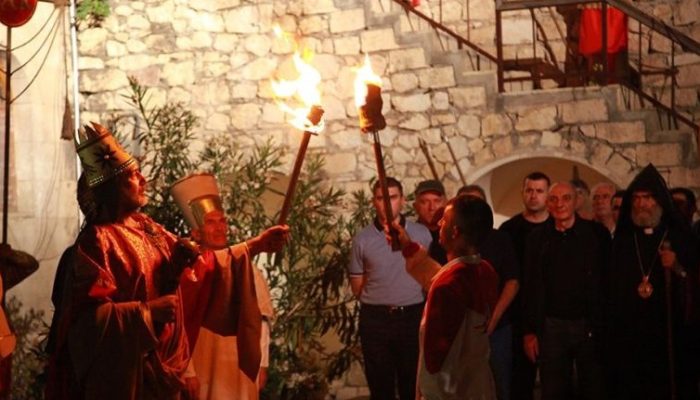The following ran in the April 22 edition of The Armenian Reporter International.
The Armenian Massacres in the Ottoman Empire : A Disputed Genocide
Review by Marc Aram Mamigonian
Guenter Lewy, the author of The Armenian Massacres in the Ottoman Empire: A Disputed Genocide ( Univ. of Utah Press ), was born in Germany in 1923, from which he emigrated in the late 1930s to Palestine and then to the United States . He has taught as a political scientist at Columbia University , Smith College , and the University of Massachusetts at Amherst , from which he retired in 1985. He is known for his revisionist writings on the Roma (i.e., Gypsies) and the Native Americans, both of which concluded that these groups suffered greatly but were not victims of genocide.
I may as well add that like Lewy, I am not a scholar of the Armenian Genocide, of Armenian history, or of Ottoman history, and I, like Lewy, lack the language competency or training as a historian to even pretend to be. I am, however, well read in the historiography in English, on “both sides of the issue,” as they say, and possess a functioning critical mind.
Lewy’s best-known book is probably America in Vietnam (1978), a revisionist take on that particular dark chapter in U.S. history that put the best possible face on America ‘s intentions and actions. The book is notable for its attempt to discred John Kerry and his involvement with the “Winter Soldier Investigation” in Detroit in 1971 which publicized alleged American war crimes and atrocities in Vietnam . According to reporter Tom Bowman of the Baltimore Sun , writing on February 14, 2004:
In his book, America in Vietnam , author Guenter Lewy noted a subsequent inquiry by the Naval Investigative Service that found that many of the veterans who spoke in Detroit refused to be interviewed even when offered immunity, and some who reported the most grisly atrocities were fake witnesses who had used the names of real veterans.
In an interview, Lewy termed the Winter Soldier project “completely unreliable and untrustworthy” and doubts that Vietnam War atrocities were officially condoned or as widespread as the Detroit testimony indicated.
Lewy said he does not recall if he saw a copy of the naval investigative report or was briefed on its contents. “I’m quite confident the information is authentic,” he said.
Naval Criminal Investigative Service public affairs specialist Paul O’Donnell told the Chicago Tribune on February 22, 2004, that he “could not confirm the existence” of the report. As those who followed the Kerry campaign for the U.S. Presidency and those who follow denial of the Armenian Genocide both know all too well, however, sometimes merely casting doubt is all that is needed.
In his preface to The Armenian Massacres , while taking shots (mostly borrowed from an article by Gwynne Dyer, “Turkish Falsifiers’ and Armenian Deceivers,’” written some thirty years ago [ Middle Eastern Studies , January 1976]) at both Armenian and Turkish historiography on the Genocide, Lewy – the possessor of “Olympian fair-mindedness,” as fellow denier Norman Stone of Bilkent University in Ankara terms it on the dust jacket – states: “Unlike most of those who have written on the subject of the Armenian massacres and who are partisans of one side or the other, I have no special ax to grind” (x), thus positioning himself as being above the alleged partisanship that, as Lewy would have it, leaves an irremovable taint on both Turks and Armenians who work as scholars on the subject.
A different way of saying this would be that Lewy, a political scientist who has written books about the Vietnam War, communism in America, the pacifist movement in America, and the Holocaust, whose work has demonstrated a total lack of involvement with or training in the issues surrounding the Armenian Genocide, and who does not possess the language skills to undertake substantially new work in the area, is in fact the ideal person to address this history in a definitive fashion.
Lewy states, puzzlingly, that “even a person who knows Turkish and can read it in the old script most likely would not be able to write a definitive history of these occurrences” and “Indeed, a requirement that only persons fluent in the Turkish language be considered competent to write on this topic would disqualify most Armenians, who also do not know Turkish” (x, xi). I shall let pass without comment the non sequitur of the latter statement (“most Armenians” don’t write books), and Lewy is in fact criticizing himself. But I think it safe to say that the subtext here is even though Lewy does not know Armenian or Turkish he still feels himself qualified to render judgment on the historiography because he is looking at things “objectively.”
It is noteworthy that Lewy does not acknowledge who assisted him with Turkish materials -as a scholar might normally do in such an instance- at the conclusion of his preface. He simply thanks “those who have translated some important Turkish materials for me” (xiii). Sometimes silence speaks louder than words.
As for “no ax to grind.” Perhaps. We may never know Lewy’s motives in writing the book – except for the yearning for truth that drives all scholars, surely. To the extent that we are know by the company we keep, though, it is noteworthy that he spoke at a symposium at Gazi University in Ankara in November 2005, along with the Who’s Who of Turkish Denial. Among the other speakers was one Gunay Evinch, who spoke on “The Armenian Pressure on the Freedom of Expression in U.S. and the Lawsuit Brought by the Turkish Americans in Massachusetts .” Evinch is a Vice President of the Assembly of Turkish American Associations (ATAA), which is, of course, one of the plaintiffs in the lawsuit. He is also a principal at Saltzman & Evinch, the Washington law firm (see www.turklaw.net). Thus, it is hardly surprising that David Saltzman, Evinch’s partner, was the first to post a review (glowing, of course) of Lewy’s book on Amazon.com before the book was available for sale. Likewise, Lewy’s articles that provided a foretaste of the book began appearing just before the Massachusetts lawsuit was filed. One can regard these as coincidences, or not.
One notes also that Lewy’s article “Revisiting the Armenian Genocide,” which appeared in the Fall 2005 Middle East Quarterly , also appeared in the July-September 2005 Insight Turkey magazine. It is somewhat unusual to publish a “scholarly article” simultaneously in two publications. What is Insight Turkey ? It is published by the Ankara Center for Turkish Policy Studies (ANKAM), with Suat Kiniklioglu, editor in chief. (Kiniklioglu is also director of the Ankara office of the German Marshall Fund of the United States .) Insight Turkey is evidently a sub-entity of ANKAM, and both appear to have a connection to SDS International, “ Turkey ‘s Leading Private Investigations, Security, and Risk Consultancy Company.” The Insight Turkey , ANKAM, and SDS International websites each link to each other, and only to each other. It is not clear if they are sibling organizations or a parent and subsidiaries.
The Armenian Massacres follows a pattern already familiar to readers of Lewy’s article “Were American Indians the Victims of Genocide?” (published in Commentary in 2004) and The Nazi Persecution of the Gypsies (2000), and perhaps other of his works which I have not read. The template, to which Lewy adheres with the rigidity of a priest reading the liturgy, is as follows:
state clearly the argument you are going to proceed to question
state that you have no desire to minimize the suffering of the group in question
establish your objectivity by pointing out the rhetorical excesses of some of the arguments on both sides
raise questions about the total population of the victim group (thus setting up later questions about the number of deaths)
duly note that, while it can in no way excuse the harsh treatment that befell them, the group in question did plenty of despicable things themselves; then describe them in detail, but reiterate that it has no bearing on the question of genocide
recite in detail the history of the mass killings, remembering to stress the magnitude of suffering and establish your empathy with their loss
finally, come to the pre-determined conclusion that while what happened was certainly a terrible human tragedy, it most certainly was not genocide
I will not go through Lewy’s book page by page, although I have done so and marked relevant passages. Most of the book gives the impression of a fairly straightforward recitation of the events of 1915-16. Lewy does not deny massive Armenian deaths, but he finds no evidence of premeditation or intent (which he seems to regard as the same thing). He chastises both the “Armenian version” that “maintains that the Armenians were the innocent victims of an unprovoked act of genocide” (ix) – as opposed to a “provoked” act of genocide? – and the “Turkish version” which asserts that the Armenian minority of some 2 million who could not legally bear arms until 1908 and who were known proverbially as the “loyal millet [nation]” rose up in massive numbers against the Turks, who controlled the military, the government, the means of transportation and communication, and who were allied with the mighty German Empire, in a great “civil war.”
Lewy insists that he is not interested in “nomenclature” – i.e., whether the “massacres” constitute genocide in the legal sense. He is a historian and therefore above such mundane concerns: “I have concentrated on what appears to me to be the far more important task of clarifying what happened. The issue of the appropriate label to be attached to these occurrences is relevant for the ongoing polemics between Turks and Armenians. It is of secondary importance for historical inquiry …” (xii).
For all his disavowal of any interest in the terminology of genocide, Lewy spends a substantial amount of time and energy in the book and in recent articles in the neo-conservative outlets Middle East Quarterly and Commentary dwelling on the issue of intent – patently in an attempt to demonstrate that genocide is not the correct term without having to come out and say it. Of course, Lewy should be aware that any time an independent body has looked at the “events” of 1915-16, it has concluded that they do constitute genocide in both the general and legal senses of the term. Furthermore, in 1997 the International Association of Genocide Scholars, the major body of North American and European scholars of all genocides, formally recognized it as such. Clearly this does not impress Lewy, who pooh-poohed the IAGS in a letter to Commentary as “self-proclaimed experts on Ottoman history [who] have never set foot in an archive or done any other original research on the subject in question” (Feb. 2006, p. 8) – a description that fits Lewy himself better than those at which it is directed.
One notes that Lewy was interested enough in nomenclature in The Nazi Persecution of the Gypsies to state: “in my view, the various deportations of Gypsies to the East and their deadly consequences do not constitute acts of genocide” in any meaningful sense of the word, including the 1948 U.N. definition (223). In “Were American Indians the Victims of Genocide?” Lewy determines that “the sad fate of America ‘s Indians represents not a crime but a tragedy.” It is possible that Lewy has had an epiphany regarding the role of the historian and the use of legal nomenclature. But, more likely, he knew he could get away with writing that because the Gypsies and the Native Americans do not have the worldwide support structures that Armenians do. With the Armenians Lewy could always say, in a pinch, “I didn’t say it wasn’t a genocide; I just said that I could find no conclusive evidence that it was.”
Lewy diminishes to the point of insignificance the post-war trials in Constantinople ; and he regards the evidence of the involvement of the Special Organization (Teºkilat-i Mahsusa) as non-existent. He is especially critical of Vahakn Dadrian’s work on these subjects. (Dr. Dadrian who was born in Turkey and possesses full command of Turkish, is widely considered to the foremost scholar of the Armenian Genocide in the world.) For Lewy, the Armenian deaths were not the result of a centrally planned, intentional campaign of extermination – what Raphael Lemkin invented the term “genocide” to describe. Lemkin himself would beg to differ with Lewy. Lemkin, in a 1949 interview with CBS Television, stated: “I became interested in genocide because it happened to the Armenians.”
To Lewy, what befell the Armenians was more a question of bad judgment, bad luck, bad planning, bad weather, bad local officials, and bad Kurds. All in all, Lewy wears the mask of the agnostic: There may have been an Armenian Genocide, but there is not sufficient evidence to say for sure; and he seems uncannily sure that there probably never will be. Lewy, evidently, is able to see into the future as well as the past.
There is, then, unintended comedy in Norman Stone’s dust jacket effusion that Lewy’s book “now replaces everything else.” I realize dust jackets are not the place for measured appraisals, but such a statement is daft even by Stone’s standards; unless by “everything else” he means less sophisticated works of denial.
One has to wade through 252 of the book’s 272 pages of prose (excluding notes, bibliography, index, etc.) before one gets to a statement which should be placed at the beginning of the book where it belongs, in order to warn people about what they are about to get into. In the section “An Alternative Explanation,” Lewy writes: “I start with the assumption that the various decrees issued by the government in Constantinople dealing with the deportation and its implementation are genuine and were issued in good faith ” (252, my emphasis). If he offers any coherent justification for this extraordinary leap of faith, I missed it. Evidently the dictators who ruled the Ottoman Empire were gentlemen of their word, and that is good enough for Dr. Lewy. Generally, though, a modicum of skepticism is helpful, especially when the disparity between the alleged intent of the decrees and the results is so vast, not to say unbridgeable. “Credo quia absurdum!” I believe it because it is absurd!
These orders, lest we forget, allegedly provided for the “temporary” exile of the Armenians, for the protection of their property by the government (while they were away), and their safety and comfort during their journey. Lewy, from his Olympian height, perceives that “[t]he momentous task of relocating several hundred thousand people in a short span of time over a highly primitive system of transportation was simply beyond the ability of the Ottoman bureaucracy” (253). This presumes, of course, that the Ottoman leadership (1) desired an efficient relocation and (2) was totally unaware of the “primitive system of transportation” that existed in their lands and the obvious consequences of their actions – even though, as Lewy notes, their “own population” (meaning Turks – Lewy seems to forget that the Armenians were Ottoman citizens, too) and their own army were suffering terribly from the same “primitive system” and its consequences.
In fact, Lewy infantilizes the Ottoman leadership. Like children, they are not to be held responsible for the consequences of their actions. The mass executions, the shootings, the rapings, the drownings, the starvation, the disease – this was not at all what they had intended. Just a temporary relocation to the Syrian desert .
In Lewy’s version of history, no one could have foreseen that it would all go so badly. Except that so many people did: Germans, Turks, Americans, British, pretty much anyone who saw what was happening – and many people did, and they wrote about it. But Lewy discards their first-hand impressions and eye-witness accounts as being no proof of governmental intent to exterminate. Why believe them, when you have the word of the Ottoman government that the temporary deportation was to be carried out in a humane fashion? Why would they lie about such a thing?
But of course the Ottoman government also foresaw the outcome, as Armenian property, allegedly being held in safety until their eventual return, was liquidated as “abandoned goods” in August 1915. The government knew that the Armenians were not coming back, because most of them were already dead.
Lewy’s book has the imprimatur of a university press; it is clearly written, a brisk read, as such books go; it does not engage in the traditional hamfisted denialism. For all of these reasons, it will quickly come to be cited by denialists as an “impartial” work. In the end, it contribute nothing to the understanding of the Armenian Genocide but it does establish a new benchmark of sophistication in the denial of that Genocide. It is no longer sufficient to deny bluntly the existence of the Genocide. One must contextualize and stress that the issue is “controversial” and that there are always two sides to each historical issue – and so there are. Sometimes, though, one side is supported by facts and the other is not.
Marc A. Mamigonian
Director of Programs and Publications
National Association for Armenian Studies and Research ( NAASR )



